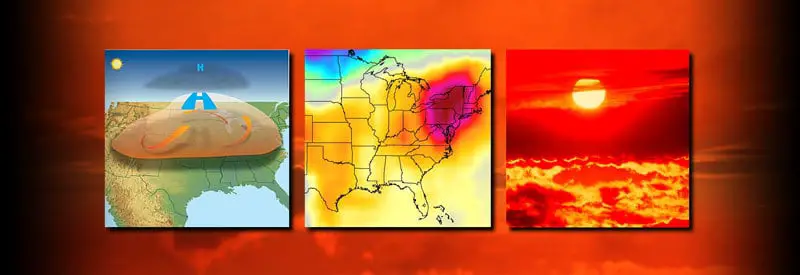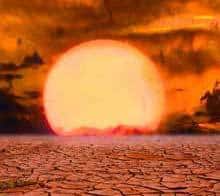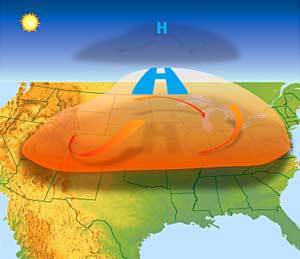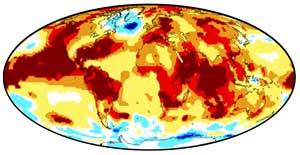Heat Waves – What They Are And How They Occur

Over the last two centuries, global air temperatures have started to show an alarming increase in average and record highs. This also led to an increase in meteorological phenomena known as heat waves.
A heat wave is defined as an extended period of abnormally high temperatures in a specific region. Conditions are officially declared a heat wave when the daily maximum temperature is at least 5° Celsius or 9° Fahrenheit warmer than the average maximum temperature for five consecutive days or more.
As this trend continues and starts to have a more permanent impact on the environment and us humans, we are facing some serious questions that need answering.
These intense hot spells that can last anything from a few days to several weeks are called heat waves. Very few people understand what exactly a heatwave is, how it differs from just an unusually warm day, and what causes it in the first place.
This topic will be the primary focus of this article. We will examine what precisely a heatwave is, as well as the processes responsible for its formation. We also look at the possible link between heatwaves and Climate Change.
Then we also look at some recent record temperatures to put everything into perspective.
Heat Wave Definition
Simply experiencing a few hot days or an unusually warm summer does not mean you in the midst of a heatwave. There are a few minimum requirements that need to be in place for hot conditions to be classified as a heatwave:
Definition Of A Heatwave

A heat wave is defined as an extended period of abnormally high temperatures in a specific region. Conditions are officially declared a heat wave when the daily maximum temperature is at least 5° Celsius or 9° Fahrenheit warmer than the average maximum temperature for five consecutive days or more.
However, many countries and regions have their own classification systems, which may better suit their environments.
In California, for example, a heat wave is declared when temperatures reach or exceed 100° Fahrenheit (37.8° Celsius) for three days or longer. It must also occur over a large region (tens of thousands of square miles).
In the United Kingdom, a heatwave occurs when the maximum daily temperatures reach or exceed the heatwave temperature threshold for three consecutive days. This threshold varies, depending on the country in the UK.
As you can see, there are quite a few variations, but the fundamental principles that define a heatwave remain the same.
What Causes A Heat Wave?
The most important cause of the majority of heatwaves is the presence of a high-pressure system. These pressure systems are commonly found during the summer months in both the Northern and Southern Hemisphere.
A slow-moving high-pressure system at heights of 3 000 to 7 600 meters (10 000 to 25 000 feet) puts a tremendous amount of pressure on the air below it. It can stay in position over a region for days or weeks, which contributes to the formation of a heatwave in more than one way.

First, the high-pressure system creates downward pressure on the air below it. As it pushes down on the underlying air, it warms it up through a process called adiabatic compression.
Secondly, the underlying compressed layer of air already heated due to adiabatic compression forms a temperature inversion above the air near the surface of the ground.
The inversion layer effectively traps the air at the surface of the planet. This warm air that would have dissipated through convection under normal circumstances now has nowhere to go as the sun warms up the earth and the air above it.
As a result, the combination of the warm inversion layer with the trapped surface air underneath it continuously warming up creates the perfect environment for the occurrence of a heatwave.
There are also other factors at play in the creation of a heatwave, and it can occur under a variety of different circumstances. However, the scenario described in this section is the primary cause of the vast majority of heatwaves.
Relationship Between Heatwaves & Climate Change
Climate Change is either the primary source of the frequent, increasingly warmer heatwaves we are experiencing or has nothing to do with their occurrence at all. It all depends on who you talk and listen to.
The truth lies somewhere in between. The answer can be summed up in two facts that will explain the relationship between the two phenomena.
The argument raised by many that heatwaves have always been a natural occurrence throughout history is a valid one.
Since humankind started keeping records of meteorological events, sustained periods of unusually hot weather were measured. As a result, it should be clear that Climate Change is not necessarily the cause of heatwaves.

But this is where Climate Change, more specifically Global Warming, starts playing a more active role. By now, there is no more dispute that human activity has activity accelerated the heating of Earth since the Industrial Revolution, a trend that is continuing today.
As a result, average maximum temperatures keep rising almost every year as a direct result of Global Warming. Studies show that this will not only cause heatwaves to grow in severity but in frequency as well. Simply put, even hotter heatwaves occurring more often.
Some Of Highest Temperature Ever Recorded
During the time of writing this article, a heatwave swept through Europe, breaking longstanding records all over the continent. Although a coincidence, this serves as a reinforcement of the information provided throughout this article.
The United Kingdom experienced its hottest July ever in 2019. During the same period, Paris also experienced its hottest day in history. The temperature reached a scorching 42.6° Celsius (108.6° Fahrenheit), eclipsing the previous seventy-year-old record.
During this period, countries like Belgium, The Netherlands, and Germany also measured record highs.
In July 2018, Death Valley in the United States recorded the hottest month ever recorded anywhere in human history. The average (day and night) temperature was 42.2° Celsius (108.1° Fahrenheit).
What makes it even more astonishing, is that this is the second year in a row that the record gets broken. The previous record was set back in 1917.
The Southern Hemisphere also saw records broken in recent times. For example, Australia experienced its hottest month ever during January 2019 when average temperatures exceeded 30° Celsius (86° Fahrenheit) for the first time in history. Daily temperatures regularly exceeded 40° Celsius (104° Fahrenheit).
One can continue, but it is becoming evident that a clear trend is emerging.
Conclusion
This article provided you with a clear explanation of what a precisely a heatwave is. You will also have a clear understanding of how different weather conditions contribute to the occurrence of this phenomenon.
Judging from the long list of record high temperatures measured across the world, it will also become evident that a worrying trend is developing.
Although Global Warming is not directly responsible for the occurrence of a heatwave, it has a significant impact on the intensity and increased frequency of these hot spells.
No to be the bearer of bad news, but we are facing a very hot future, where increasing heatwaves across the planet will become more commonplace.
Never miss out again when another interesting and helpful article is released and stay updated, while also receiving helpful tips & information by simply clicking on this link .
Until next time, keep your eye on the weather!
